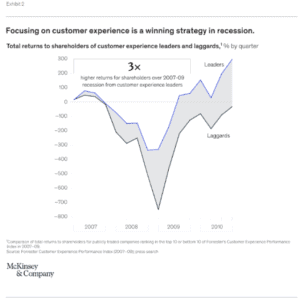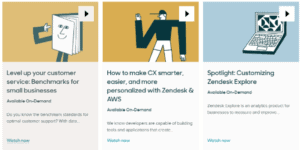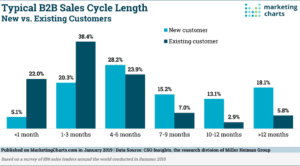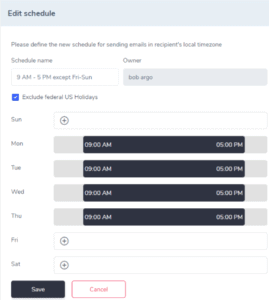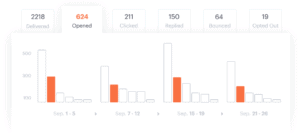Introduction
Sure, being a salesperson can be stressful.
But have you tried being a customer lately?
We’re totally serious, by the way.
Despite the wealth of sales enablement tools at the fingertips of modern sales teams, reaching customers in their inboxes today often feels like an uphill battle.
Why, though?
Unfortunately, there’s no single symptom that’s making modern customers so hard to reach.
Yeah, our shrinking attention spans might be partially to blame. Maybe it’s the public’s general distrust of sales and marketing.
Or perhaps it’s because the average consumer is being bombarded with sales messages (more than 88 per day, on average).
Listen: if you suspect that your prospects are burnt out on being sold to, you’re exactly right.
That’s why brute force marketing blasts and one-size-fits-all outreach campaigns are going the way of the dinosaur.
Reaching customers today means rethinking your approach to outreach, plain and simple.
And believe it or not, it’s possible to form meaningful relationships with customers and scale your email efforts at the same time.
In this guide, we’ll break down the specific trends, tactics, and principles modern sales teams should keep in mind when planning and executing their outreach campaigns in 2020 and beyond.
Trend #1: Customers Today Crave Trust and Empathy
The 2010s marked the beginning of “the Relationship Era” of marketing, and 2020 has only solidified it.
The concepts of “trust” and “empathy” might seem like they’re reserved for talking about close personal relationships.
However, these concepts are now the baseline for converting leads and creating long-term customers.
There’s no denying that product features and price points are important.
But if you aren’t focusing on making human connections during your outreach, you’re likely wasting your time.
Sound like fluff? Don’t take our word for it. McKinsey & Company report that during the 2007 economic downturn, businesses that focused on customer experience saw 3x higher returns.
It makes sense. People have a lot on their minds. There’s no time to hear out an indifferent rep just trying to make a sale.
Your prospects are more than opportunities. Your customers are more than dollars and cents.
You know that. But do they?
Building trust and conveying empathy are both must-dos during sales outreach that modern teams can’t afford to overlook.
Like, literally.
Takeaway: Meet Customers Where They Are With Empathetic Communications
This might be a no-brainer, but salespeople need to meet their customers where they are now.
Where do your customers spend their time? How can you show them that you understand their situation?
Being flexible to communication channels, and showing customers that you understand and respect their situation has become more important than ever. Successful companies are continuously pivoting to meet prospects in the channels where they spend the most time.
Email usage is dropping for example, while calls, virtual and otherwise, are on the rise. SMS and messengers have also risen as personal and professional lives become more intertwined.
Don’t be afraid to use personal messaging and check on your prospect’s status before moving on to marketing. In addition to showing your willingness to communicate from a human standpoint, it will give you a chance to discover the prospect’s situation and needs.
And there’s arguably no better way to get to know your customers’ situations than through interviewing them. As noted by Atlassian, a brief interview with a customer can be an eye-opener in terms of zeroing in on pain points.
Oh, and don’t neglect the need to be 100% up-to-date on your product and its latest features as a salesperson. Try to put yourself in your prospects’ shoes, connecting the dots between your product and their desires.
Trend #2: Customers are Overwhelmed with Company Choices and Product Information
Whenever you pitch a prospect, it’s safe to assume they’re going to do their own homework to learn more about what you’re selling.
And hey, rightfully so.
This 2019 report from Gartner notes that 62% of people go beyond talking to salespeople and conduct their own research before making a buying decision.
Makes sense, right?
There’s a problem, though.
Chances are you’re not the only show in town when it comes to your industry.
Once your prospects start going down the rabbit hole of figuring out the specifics and benefits of your product versus your competitors, the end result is often analysis paralysis.
The aforementioned Gartner report highlights some key statistics regarding the phenomenon of information overload among today’s consumers:
- 55% feel overwhelmed by information while researching products
- 44% struggle with product-related information from multiple sources that seems contradictory
- 15% spend time trying to decode conflicting messages between vendors
Before you drown your prospects in resources and statistics via email, consider how people don’t necessarily need more information: they need the right information.
Takeaway: Empower Your Customers to Draw Their Own Conclusions
Rather than drop general links or resources in your outreach emails, point your prospects to resources that speak specifically to their needs.
And of course, figuring out what those needs are means asking questions.
For example, let’s say that someone’s curious about a specific feature of your software or wants a walkthrough about how they can use that software for their niche industry.
Companies like Zendesk have an entire repository of webinars that speak to every section of their audience. Whether someone’s looking for a case study or a full-blown tutorial, they have an in-depth resource to reply with.
Salespeople should strive to stick to the principle of “Show, don’t tell.” By delivering relevant resources like these, you set up the “Aha!” moment that results in a sale without overloading them with information.
Trend #3: Customers are Wary of Salespeople and Cold Outreach
Spoiler alert: people traditionally don’t enjoy being sold to.
Not much of a surprise, right?
That said, the degree to which modern buyers detest sales spam is staggering.
Here’s a sobering stat: recent research from Forrester notes that consumer trust in sales and brand-related messages is at an all-time low.
Yikes.
Coupled with the fact that cold emails have a response rate of less than 1%, it’s clear that people will go out of their way to steer clear of salespeople if given the chance.
This growing sense of distrust ties directly back to the previous trend. Salespeople in general receive their negative reputations when they treat prospects like numbers rather than people.
Takeaway: Research Your Prospects to Personalize Your Pitch
The good news? There are more resources available than ever to empower sales teams to make meaningful connections with their prospects.
Heck, social media alone provides ample opportunities to learn more about your outreach targets and warm up an otherwise “cold” relationship.
For example, consider how LinkedIn is an absolute goldmine for B2B outreach. The platform makes it easy to find relevant contacts based on someone’s specific role within a company. It wouldn’t make much sense to try to sell an IT product to a marketing manager, right?
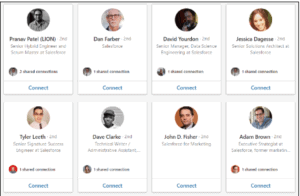
LinkedIn likewise allows you to see someone’s latest activity, “likes”, and shared content. The fact that LinkedIn lets users know you’ve viewed their profile makes your name and face familiar to them before you even reach out.
This same logic applies to the likes of Twitter or even blog comments (think: sharing and replying to your prospects’ content). These touchpoints only take a few seconds to make but can help provide positive context to your formal outreach when it happens.
And of course, you get to learn a thing or two about your prospects along the way.
What are they passionate about? Anything bugging them? What colleagues or opinions do you have in common? These small details aren’t mundane: they’re key to figuring out where you can make that ever-so-important human connection during outreach.
Trend #4: Most Sales Messages Receive Little Engagement
Now let’s dive into the nitty-gritty of sending sales emails.
According to benchmark data from HubSpot, sales email open rates for most industries hover around 20%. Meanwhile, click-through rates are typically between 6-9%.
Although these numbers might not be mind-blowing, they’re not exactly encouraging, are they?
The fact that most sales emails go unnoticed and receive almost no engagement obviously isn’t good news for salespeople looking for a greater ROI from their outreach campaigns.
There’s no denying that sales emails still work, though.
In fact, 59% of B2B marketers note that email is their biggest source of revenue.
But consider that click-worthy emails don’t happen by accident. Salespeople should understand the anatomy of an effective sales email regardless of if they’re crafting an initial outreach email or a follow-up.
Takeaway: Optimize Your Outreach Emails for Readability and Responses
There is no singular “right” way to write a sales email.
However, there is ample research that clues us in on what elements of a sales email are most important to eliciting a response.
Perhaps the most obvious place to start is your subject line. This is every email’s barrier-to-entry, one-third of people determine whether or not to open an email based on the subject line alone.
Rather than try to rely on cheap clickbait, experiment with subject lines that combine the principles above such as personalization and speaking to your prospects’ pain points.
- “Anything we can do to help, John?”
- “Let’s deal with your lead-gen problem”
- “About your latest post…”
As highlighted by tools such as CoSchedule’s subject line tester, the best subject lines are usually on the shorter side (~20 characters, 3-5 words). Referring to prospects by name in your subject lines is also a smart move.
When in doubt about your subject lines, simply ask yourself: would you click on your own headline if you saw it in your inbox?
In terms of body copy, let’s revisit our second trend.
Considering that your readers are likely busy and overwhelmed, keeping your messages short and sweet with a single call-to-action (“check out this report”) is definitely ideal. According to Sleeknote, 75 to 125 words is optimal for appealing to busy readers and prospects on-the-go.
As a final note, double-check that your emails give your readers something to do or respond to. For example, you can always conclude your messages with a question (“Are there any specific features you’re looking for?”) for the sake of keeping the conversation moving while also learning even more about your prospect.
Trend #5: Modern Customers Require Multiple Meaningful Touchpoints Before They’ll Close
It’s no secret that closing a sale requires consistent back-and-forth between leads and sales reps.
According to data from the Brevet Group, 80% of sales require at least five follow-ups. Meanwhile, a recent study published by Marketing Charts notes that 75% of B2B leads take at least 4 months to close.
Translation? Expect to send a myriad of messages to prospects prior to closing rather than a single “silver bullet” in someone’s inbox.
This all ties back to our first and second trends. Buyers are overwhelmed with options and a number of personalized, empathetic touchpoints, including phone calls, video conferences, and documents are often necessary to close a sale beyond email.
As a result, salespeople need a smart sales sequence and concept of timing when it comes to sales outreach. The right message at the right time, in short.
Takeaway: Explore Ways to Streamline and Scale Your Outreach Efforts
Most sales outreach tools offer some sort of scheduling features to target the time when your recipients are most likely to open your messages. Here’s an example from Revenue Engage:
Note that this trend revolves around “meaningful” touchpoints. In other words, your follow-ups and check-ins should be personalized based on each customers’ unique needs and history.
Other sales enablement software, for example Revenue Inbox, automatically logs all interactions between sales reps and prospects, detailing their history from A to Z.
Coupled with a sales engagement platform, companies get the best of both worlds by combining campaign scheduling with data-driven personalization to effectively target their campaigns to the leads that will respond best to them.
Having a bird’s-eye view of your outreach efforts creates a sense of accountability among your sales team, not to mention a better sense of your overall sales process company-wide. The fact that Revenue Engage tracks engagement over time is an added bonus for fine-tuning your outreach campaigns.
And with that, we wrap up our guide!
Ready to Cut Through the Noise?
No matter what you’re selling, email outreach remains a must-do for modern companies.
And anything salespeople can do to close more deals and make more efficient use of their time is a major plus.
By figuring out how to cut through the noise and speak to the needs of busy customers, you can do exactly that.
Acknowledging these trends and takeaways is the first step. With the help of outreach tools like Revenue Engage, you can speed up and streamline your email outreach sooner rather than later.
Hopefully, this guide provided you the much-needed motivation and inspiration to make it happen!
